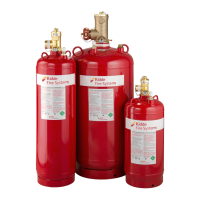Design and Installation
October 2014 4-20 06-236115-001
4-3.2.2.1 Ferrous Piping
Black steel or galvanized pipe must be either ASTM A-53 seamless or electric resistance
welded, Grade A or B, or ASTM A-53 furnace weld Class F (up to 1½” diameter) or ASTM A-
106, Grade A, B or C. ASTM B-120 and ordinary cast iron pipe must not be used. The thickness
of the pipe wall must be calculated in accordance with ANSI B-31.1, Power Piping Code. The
internal pressure for this calculation shall not be less than the minimum piping design pressure
of 402 PSIG (28 bar gauge) at 70°F (21°C). The minimum piping design pressure of 402 PSIG
at 70°F corresponds to eighty percent of the maximum pressure of 502 PSIG (35 bar gauge)
in the agent container at the maximum storage temperature at 130°F (54°C), using the
maximum allowable fill density at 70 lb/cu.ft (1121 kg/cu.m).
4-3.2.2.2 Piping Joints
The type of piping joint shall be suitable for the design conditions and shall be selected with
consideration of joint tightness and mechanical strength.
4-3.2.2.3 Fittings
Fittings shall conform to the requirements of NFPA 2001, Sections 2-2.3 and A-2-2.3.1. Class
150 and cast iron fittings must not be used. Class 300 lb malleable or ductile iron fittings in
sizes 3-inch and smaller, or 1000 lb ductile iron or forged steel fittings in sizes greater than 3-
inch are to be used. Class 300 flanged joints are acceptable for use in all sizes. All grooved
couplings and fittings shall be UL Listed and/or FM Approved (as appropriate) and have a
minimum rated working pressure equal to or greater than the minimum piping design pressure
of 402 PSIG (28 bar gauge) at 70°F (21°C).
Concentric bell reducers are the only means for reducing pipe size. Reductions can be made
after a tee or after a union. Where reducers are used at tees, the reducers must be downstream
of each tee. Reductions made after a union are possible only if the next change in direction
(tee split) is located a minimum of 15 nominal pipe diameters downstream of the concentric
bell reducer. Gaskets for flanged fittings shall be neoprene impregnated or compliant with
NFPA 2001.
CAUTION
Pipe supplied as dual stenciled A-120/A-53 Class F meets the requirements of
Class F furnace welded pipe ASTM A-53 as listed above. Ordinary cast-iron pipe,
steel pipe conforming to ASTM A-120, or nonmetallic pipe must not be used.
CAUTION
The latest version of the flow calculation software program has only been
verified for use with the piping, inside pipe diameter and fittings specified in
this manual. When unspecified piping and fittings are used, there is a risk that
the system will not supply the required quantity of HFC-227ea.

